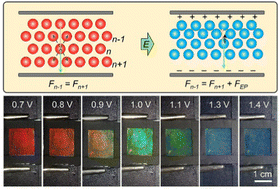Low-voltage and wide-tuning-range SiO2/aniline electrically responsive photonic crystal fabricated by solvent assisted charge separation†
Abstract
An electrically responsive photonic crystal (ERPC) in weak polar media showed good performance due to less screening of Coulombic interaction, but its synthesis was a challenge because of the difficulty in fixing the amount of charge-controlling agent and water. Here, an SiO2/aniline (ANI) weak-polar EPRC was fabricated by a simple process without using any charge-controlling agent. As an alkaline weak polar solvent, aniline not only helps to disperse the particles in solution but also renders a particle with high surface charge by taking a proton away from the silanol group, both of which favor the formation of an ERPC in a weak polar system. Compared to reported ERPCs, the SiO2/ANI ERPC possessed a broad reflection wavelength tuning range (230 nm) under a low working potential (1.4 V) due to less screening of Coulombic interaction. The low working potential further relieved the decrease in color intensity under large lattice compression and improved the long-term stability and reversibility of the reflection signals in electrical tuning.

- This article is part of the themed collection: Journal of Materials Chemistry C HOT Papers


 Please wait while we load your content...
Please wait while we load your content...